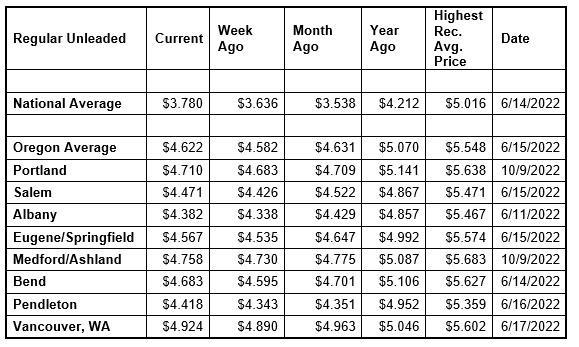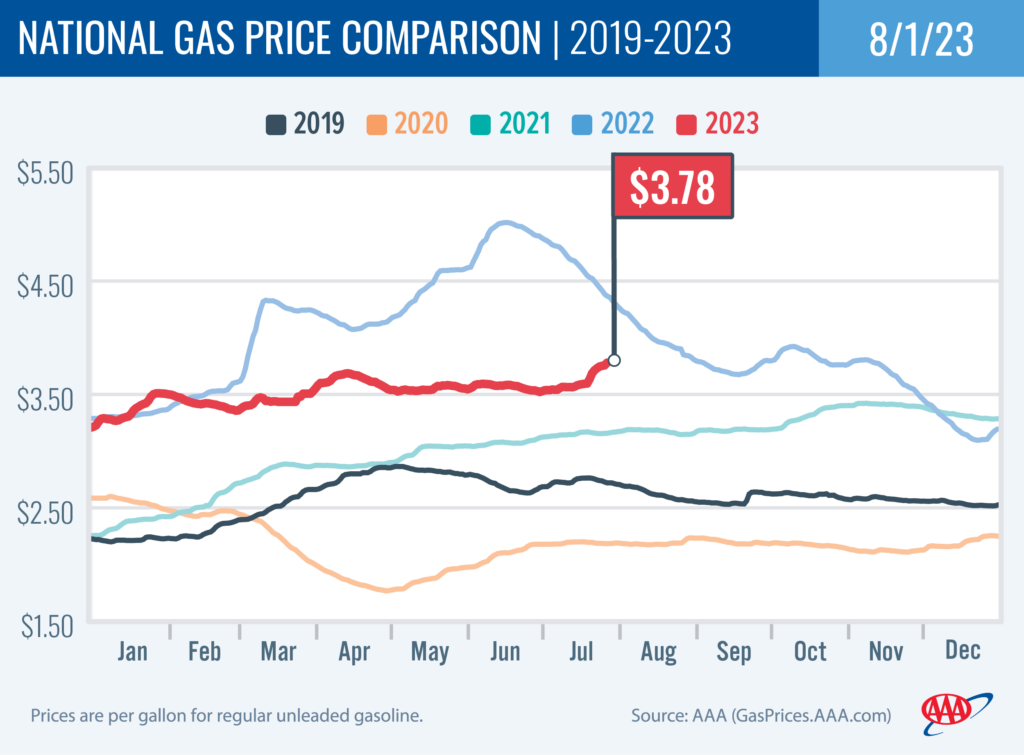PORTLAND, Ore., – The national average for regular has jumped to its highest price of the year. Surging crude oil prices and heat-related refinery outages are the major drivers. Most states are seeing double-digit jumps this week, but Oregon is one of only nine states seeing small increases. For the week, the national average jumps 14 cents to $3.78. The Oregon average adds four cents to $4.62.

“The national average is at its highest price of the year so far and the highest price since last November. The Oregon average is slightly lower than its year-to-date high price of just under $4.65 set on June 28,” says Marie Dodds, public affairs director for AAA Oregon/Idaho. “Crude oil prices have soared to their highest prices since mid-April. At the same time, extreme heat has led to outages and reduced output at some of the nation’s biggest refineries. Tighter supplies and the rally in crude prices are causing pump prices to climb.”
This summer’s extreme heat has led to outages and reduced output at a number of U.S. refineries, including those in the Gulf Coast, leading to a reduction of some 500,000 barrels per day of refining capacity.
Crude oil prices have been rising since early July after remaining in the upper $60s per barrel to the mid-$70s through May and June. This is the longest rally since before the Russian invasion of Ukraine.
Crude oil is trading around $81 today compared to $79 a week ago and $94 a year ago. In July, West Texas Intermediate ranged between about $69 and $82 per barrel. In June, WTI ranged between about $67 and $73 per barrel. In May, WTI ranged between about $63 and $77 per barrel. In April, WTI ranged between about $73 and $83. In March, WTI ranged between about $64 and $81 per barrel. In February, WTI ranged between about $73 and $80 per barrel. In January, WTI ranged between about $73 and $82 bbl. Crude reached recent highs of $123.70 on March 8, 2022, shortly after the Russian invasion of Ukraine, and $122.11 per barrel on June 8, 2022. The all-time high for WTI crude oil is $147.27 in July 2008.
Crude oil is the main ingredient in gasoline and diesel, so pump prices are impacted by crude prices on the global markets. On average, about 47% of what we pay for in a gallon of gasoline is for the price of crude oil, 24% is refining, 14% distribution and marketing, and 14% are taxes, according to the U.S. Energy Information Administration.
Demand for gasoline increased slightly from 8.86 to 8.94 million b/d for the week ending July 21, according to the U.S. Energy Information Administration (EIA). This compares to 9.25 million b/d a year ago. Meanwhile, total domestic gasoline stocks dipped from 218.4 to 217.6 million bbl. With supplies tight, if demand should spike, pump prices will follow suit.
Quick stats
All 50 states and the District of Columbia have higher prices now than a week ago. Minnesota (+25 cents) has the largest weekly jump. In all, 41 states and D.C. are seeing double-digit increases. Oregon (+4 cents) is one of nine states with weekly jumps of less than 10 cents. Utah (+1 cent) has the smallest weekly increase.
After six weeks, California ($5.01) bumps Washington ($4.96) as the state with the most expensive gas in the nation. Hawaii ($4.72) is third, Oregon ($4.62) is fourth, Alaska ($4.35) is fifth, Nevada ($4.31) is sixth, and Illinois ($4.00) is seventh. These are the seven states with averages at or above $4 a gallon, up from six a week ago. This week 43 states and the District of Columbia have averages in the $3-range. No state has an average in the $2 range this week.
The cheapest gas in the nation is in Mississippi ($3.29) and Louisiana ($3.39). For the 133rd week in a row, no state has an average below $2 a gallon.
The difference between the most expensive and least expensive states is $1.73 this week, compared to $1.84 a week ago.
Oregon is one of only five states with lower prices now than a month ago. The national average is 24 cents more and the Oregon average is one cent less than a month ago. Florida (+46 cents) has the largest monthly jump. Arizona (-3 cents) has the largest monthly drop.
All 50 states and the District of Columbia have lower prices now than a year ago. The national average is 43 cents less and the Oregon average is 45 cents less than a year ago. Idaho (-96 cents) has the largest yearly drop. Washington (-5 cents) has the smallest. Last year, crude oil prices and pump prices rose rapidly after the Russian invasion of Ukraine.
West Coast
The West Coast region continues to have the most expensive pump prices in the nation with six of the seven states in the top 10. It’s typical for the West Coast to have six or seven states in the top 10 as this region tends to consistently have fairly tight supplies, consuming about as much gasoline as is produced. In addition, this region is located relatively far from parts of the country where oil drilling, production and refining occurs, so transportation costs are higher. And environmental programs in this region add to the cost of production, storage and distribution.
| Rank | Region | Price on 8/1/23 |
| 1 | California | $5.01 |
| 2 | Washington | $4.96 |
| 3 | Hawaii | $4.72 |
| 4 | Oregon | $4.62 |
| 5 | Alaska | $4.35 |
| 6 | Nevada | $4.31 |
| 7 | Illinois | $4.00 |
| 8 | Utah | $3.96 |
| 9 | Colorado | $3.96 |
| 10 | Idaho | $3.95 |
As mentioned above, California bumps Washington as the state with the most expensive gas in the country and is the only state with an average above $5 a gallon. Washington slips to second, with Hawaii, Oregon, Alaska, and Nevada rounding out the top six. Arizona is 14th. Oregon is fourth for the eighth week in a row.
States in the West Coast region are seeing smaller increases in gas prices than other states this week: California (+11 cents), Nevada (+10 cents), Oregon (+4 cents), Arizona (+4 cents), Washington (+4 cents), Alaska (+3 cents) and Hawaii (+3 cents).
The refinery utilization rate on the West Coast fell from 92.3% to 90.9% for the week ending July 21. This rate has ranged between about 73% to 96% in the last year. The latest national refinery utilization rate fell from 94.3% to 93.4%
According to EIA’s latest weekly report, total gas stocks in the region decreased from 29.25 million bbl. to 28.11 million bbl.
A lower refinery utilization rate and a decrease in gasoline stocks can put downward pressure on pump prices.
Oil market dynamics
Crude oil prices continued to rise last week due to ongoing market expectations of tight supplies in the coming weeks and months. Global demand for oil is expected to rise, creating a gap between production and supply. Production cuts put in place by OPEC+ have exacerbated the situation. Additionally, the EIA reported that total domestic commercial crude inventories decreased by 600,000 bbl to 456.8 million bbl.
At the close of Friday’s formal trading session, WTI added $9.72 to settle at $80.58. At the close of Monday’s formal trading session, WTI added $1.22 to settle at $81.80. Today crude is trading around $81 compared to $79 a week ago. Crude prices are about $17 less than a year ago.
Drivers can find current gas prices along their route with the free AAA Mobile app for iPhone, iPad and Android. The app can also be used to map a route, find discounts, book a hotel and access AAA roadside assistance. Learn more at AAA.com/mobile.

Diesel
For the week, the national average jumps 17 cents to $4.07 a gallon. The record high is $5.816 set on June 19, 2022. The Oregon average climbs eight cents to $4.50. The record high is $6.47 set on July 3, 2022. A year ago the national average for diesel was $5.28 and the Oregon average was $6.01.
Find current fuel prices at GasPrices.AAA.com.
AAA news releases, high resolution images, broadcast-quality video, fact sheets and podcasts are available on the AAA NewsRoom at NewsRoom.AAA.com.
Find local news releases at https://oregon.aaa.com/community/media/media-contacts.html
Fuel prices are updated daily at AAA’s Daily Fuel Gauge at AAA Gas Prices. For more info go www.AAA.com. AAA Oregon/Idaho provides more than 880,000 members with travel, insurance, financial and automotive-related services, and is an affiliate of AAA National, serving more than 63 million motorists in North America.

